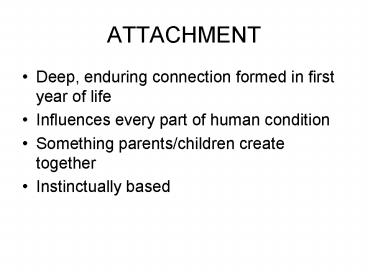ATTACHMENT - PowerPoint PPT Presentation
1 / 11
Title:
ATTACHMENT
Description:
Infants possess instinctual behaviors that serve to keep mother close ... Loss causes pathological mourning. OTHER RESEARCHERS. David Levy-'primary affect hunger' ... – PowerPoint PPT presentation
Number of Views:46
Avg rating:3.0/5.0
Title: ATTACHMENT
1
ATTACHMENT
- Deep, enduring connection formed in first year of
life - Influences every part of human condition
- Something parents/children create together
- Instinctually based
2
FUNCTION OF ATTACHMENT
- Learn basic trust and reciprocity
- Explore environment
- Self-regulation
- Identity
- Prosocial moral framework
- Defense against stress/trauma
3
ATTACHMENT RELATIONSHIP
- Touch
- Eye contact
- Smile and positive affect
- Need fulfillment
4
ATTACHMENT PROMOTES
- Self-esteem
- Independence/autonomy
- Resilience
- Ability to manage impulses/feelings
- Long-term friendships
- Relationships with authority figures
- Prosocial coping skills
- Trust, intimacy, and affection
- Positive, hopeful belief system about self/others
- Empathy, compassion and conscience
- Behavioral and academic success in school
- Secure attachment with own children
5
HISTORICAL PERSPECTIVE
- Hospital policies
- John Bowlby
- affectionless children
- early emotional deprivation
- WHO in 1951
- influence of ethologists
6
BOWLBYS CONCLUSIONS
- Infants possess instinctual behaviors that serve
to keep mother close - Smile-social releaser for infant and mother
- Anxiety, fear, illness, fatigue increases
attachment behaviors - Maternal deprivation and separation traumatic
because thwart biological need - Loss causes pathological mourning
7
OTHER RESEARCHERS
- David Levy-primary affect hunger
- Loretta Bender
- Henry Bawkin- institutional failure to thrive
- Harold Skeels
- Rene Spitz
- James Robertson-reaction to loss/separation
- protest, despair, detachment
- Harry Harlow-contact comfort
8
MARY AINSWORTH
- 1954 Uganda study- secure base
- Phases of attachment
- Undiscriminating
- Differential responsiveness
- Separation anxiety
- Active initiation
- Stranger anxiety
9
AINSWORTH
- Strange Situation
- Patterns of Attachment
- Secure
- Insecure Ambivalent/resistant
- Avoidant
- Parental Characteristics
- acceptance, cooperation, sensitivity,
- availability
10
DEVELOPMENTAL STUDIES
- Mary Main-disorganized/disoriented
- Patricia Crittenden-ambivalent/avoidant
- Bowlby- internal working model
- Alan Sroufe- longitudinal studies
11
CULTURAL VARIATIONS
- One-third in middle-class families insecurely
attached - Higher in multiproblem families
- In all cultures studied, most infants show secure
attachment patterns (68) - Ganda babies
- German families
- Israel































